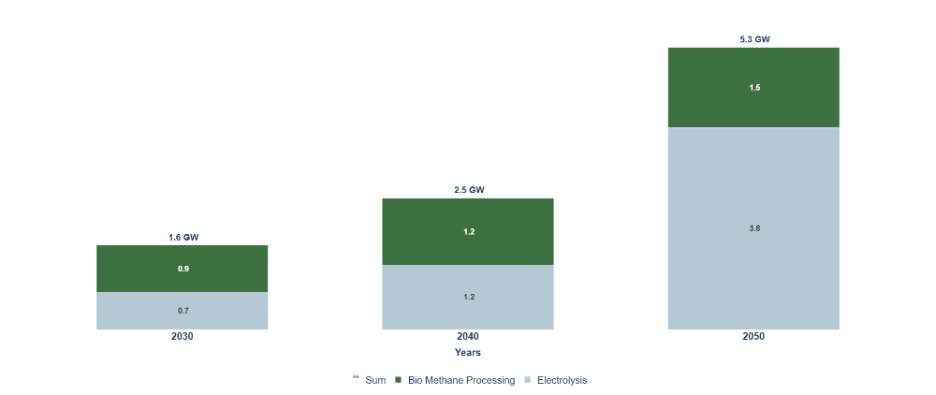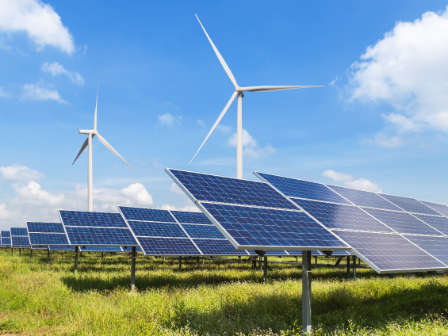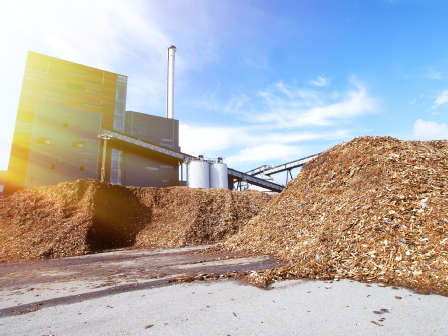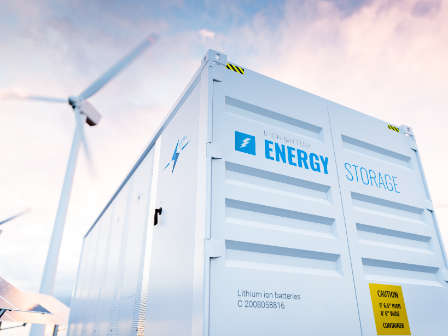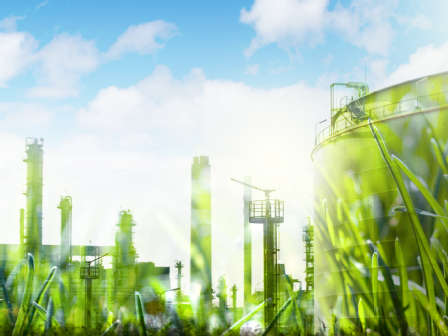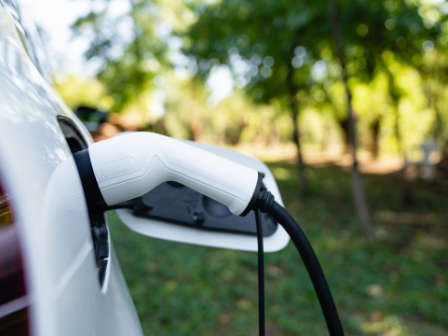
The Future of Electricity and Heating is Green, Efficient and Integrated
Thermal power plants & flexibilities are central pillars of the security of supply
The vision of Wien Energie for a decarbonized energy future
As Austria's largest regional energy provider, Wien Energie reliably supplies two million people and 230,000 commercial and industrial facilities with energy. Our top priorities in this context are security of supply and climate protection. The goal is to guarantee a climate-neutral energy supply in the long term, based on an integrated supply of electricity, heating and cooling solutions for Vienna. Our objective is to make Vienna climate-neutral by 2040.
Highly flexible thermal power plants based on green gas will continue to play a central role in securing the supply of heat and electricity in Austria. However, at the moment, Austria does not have a favorable framework for urgently needed investments in the construction of new and highly flexible plants. In addition to thermal power plants, large heat pumps and heat storage systems, as well as electric heaters, contribute to the provision of flexibility in the electricity market and heating and cooling generation. A comprehensive power plant strategy that takes all technologies into account is therefore crucial for the success of a decarbonized energy system in the future. This is the only way to effectively minimize the economic costs of converting the energy system while maintaining the high standard of security of supply in Austria.
Results at a glance
A massive expansion of renewable electricity generation is necessary for achieving the ambitious climate targets. Vienna in particular, is making an important contribution to decarbonization through the strong expansion of PV systems on roof surfaces.
Large-scale battery storage systems make an important contribution to the security of supply and increase the stability of the electricity grid. They also contribute to the integration of renewable energy sources.
The district heating supply of the future requires a diverse generation portfolio that includes large heat pumps, deep geothermal energy, refuse incineration plants with CO2 capture and highly flexible green-gas based thermal power plants.
Heat storage, heat pumps and decarbonized CHP plants as well as peak load boilers offer the necessary flexibility to ensure the security of supply for district heating. These technologies also ensure an efficient, sector-coupled overall energy system.
For a climate-neutral Austria, investments in thermal capacities, which are primarily fuelled by green gas, are essential to ensure the security of supply in the electricity sector. However, the necessary framework for these investments is currently lacking.
Green gases such as biomethane and hydrogen play a decisive role in decarbonization. In addition to green gas imports, the domestic production of green gas will become increasingly important by 2050.
Assumptions for the system vision of Wien Energie
The scenario is intended to show an ambitious decarbonization path. It is based on the strong expansion of renewable energy sources. Flexibilities and controllable power plants will ensure a secure energy future.
The results of the model-based analyses as part of zusammEn2040 in detail
Based on the assumptions made by Wien Energie and the parameters entered as a result, the energy system model (ESM) calculates an "optimal" energy system on the path to 2050. The most important findings are presented below:
Expansion of renewables is the basis for achieving climate targets
The electricity demand in Austria will almost double by 2040. In Vienna, PV generation, in particular, will be greatly expanded. In the summer, PV systems cover a significant proportion of the energy demand, while highly flexible thermal power plants and electricity imports dominate in winter.
Electricity generation in Vienna in 2040 in MWh

Battery storage systems make an important contribution to the security of supply
The expansion of battery storage systems is part of the overall restructuring of the electricity supply. In the future, the electricity system will be characterized by a very high proportion of volatile generation (wind power and PV). A highly volatile generation system requires significantly more battery storage to shift the load in times of high renewable generation. Investments in battery storage and available power plant capacities are necessary and help to reduce the need for investments in the expansion of grid capacities. This can mitigate the costs for consumers.
The capacities of large-scale battery storage systems in Austria will increase considerably to 3.2 GW in the coming years. This technology makes a significant contribution to decarbonization as it facilitates reliable and flexible use of electricity from renewable sources. It therefore makes an important contribution to the security of supply and increases the stability of the electricity grid.
In contrast to hydraulic pumped storage power plants, large-scale battery storage systems are currently subject to double charges: They have to pay grid fees, taxes and levies both for the intake of electricity (storage) and for the release into the grid (withdrawal). A level playing field is therefore needed with regard to the fees for storage technologies to ensure fair competitive conditions.
Installed capacity of large-scale storage batteries in AT in 2040 in GW

Large-scale battery storage and withdrawal in AT in MWh electricity

District heating supply requires a broad generation portfolio
In the future the generation of heat for district heating will be based on the interaction of a wide range of technologies - from power-to-heat solutions such as large heat pumps and electric heating appliances to geothermal energy, waste and biomass incineration and the use of thermal power plants.
The use of controllable thermal power plants will still be indispensable to ensure that the demand in the heat and electricity sectors can be met. In the future, these plants will be operated with green gases such as hydrogen and biomethane.
Development of the district heating supply in AT in TWh of heat
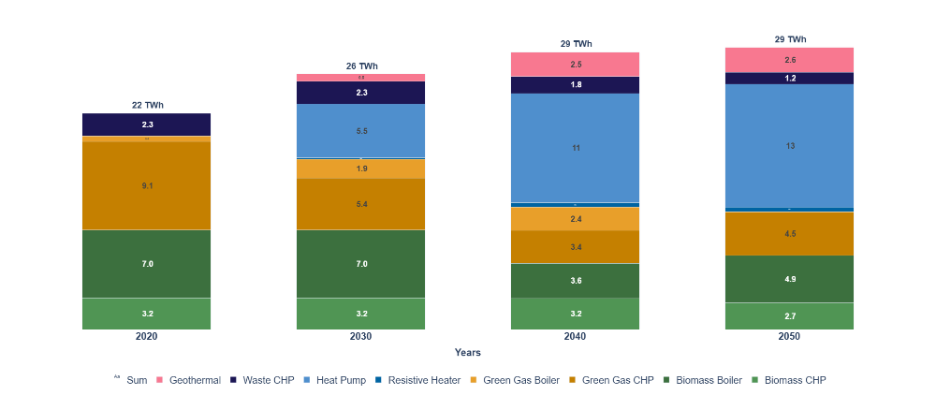
Flexibilities support the security of supply in district heating
Flexible technologies such as large heat pumps and thermal power plants will play a decisive role in the provision of district heating in the future, especially during the heating season. At the same time, these technologies can provide flexibility in the electricity sector.
In addition to CHP plants, decarbonized boilers and heat storage systems will also play a key role in covering peak loads. The results also highlight the increasing importance of heat storage systems for the provision of district heating. Heat storage systems are mainly used for daily and multi-day balancing.
Time sequence of district heating generation in 2040 in MWh (daily total values)

Green gas-based, highly flexible thermal power plants will ensure the security of supply during cold dark doldrums
Highly flexible thermal power plants will continue to play a central role in the security of heat and electricity supply in Austria. Although the plants will have fewer full-load hours in the future, they will remain indispensable, particularly for covering peak loads in the heating and electricity sectors during dunkelflauten (lit.: cold dark doldrums or dark wind lulls).
At the moment, the necessary framework for investments in these plants is lacking in Austria. An intensive dialogue on establishing an appropriate framework regarding the remuneration for the provision of flexible power plant capacities (e.g., through the introduction of a capacity mechanism) is therefore necessary.
Time sequence of the electricity generation by green gas CHP plants in 2040 in AT in MWh

Demand for green gases will increase massively in a decarbonized energy system
The production capacities for renewable gases (biomethane and hydrogen) have to be significantly expanded by 2050, particularly electrolysis and biomethane plants. These power plants will make a significant contribution to achieving climate neutrality in Austria. The electrolysis capacity of green hydrogen contributes significantly to decarbonization and will increase to 3.8 GW of hydrogen production (or 4.8 GW electrical output) by 2050. In 2040, biomethane plants with a capacity of 1.2 GW will be in operation, producing around 10 TWh of biomethane per year.
Development of installed hydrogen and biomethane production capacities in GW (thermal)
